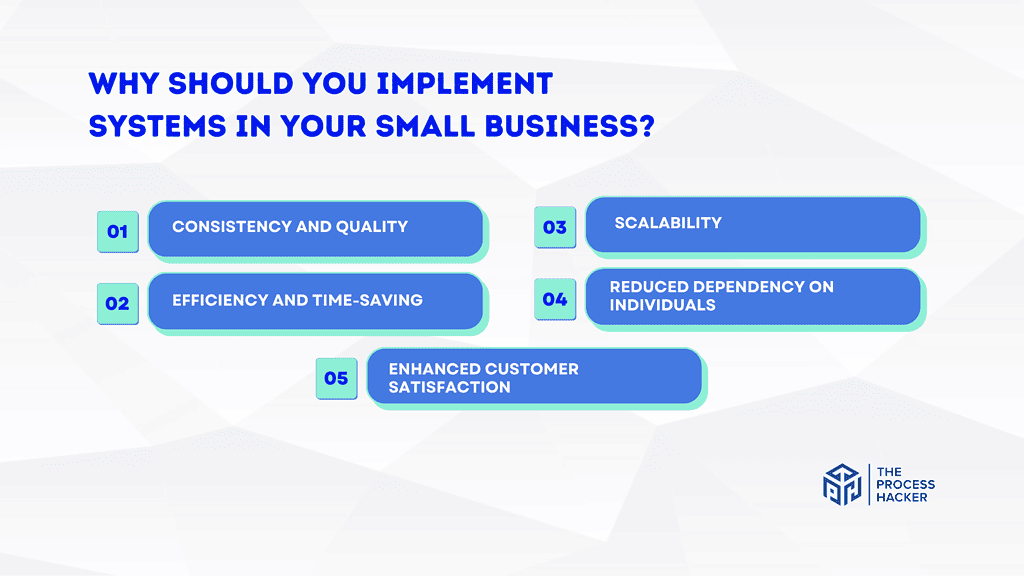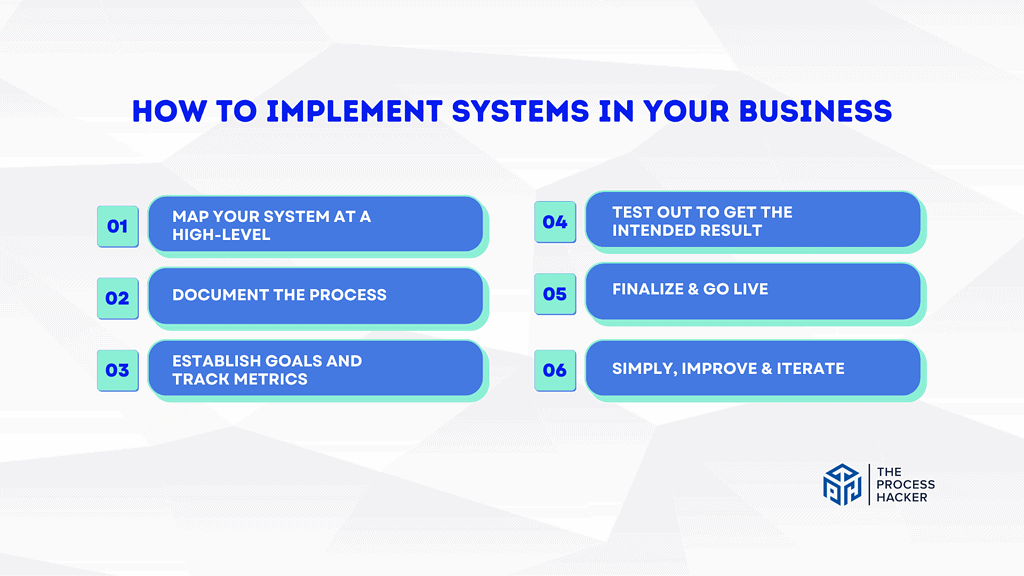How To Create Systems In Your Business: The Process Hacker Way
Are you stuck in the cycle of managing your business, and despite your efforts, it’s still not growing? No matter how hard you work, do you never seem to get ahead?
If so, it’s time to build business systems and automate your business!
This guide, “How To Create Systems In Your Business,” will show you how to do that! We’ll show you simple and effective ways to create systems to increase small businesses’s productivity.
Don’t get bogged down in the day-to-day management of a small business.
This post will give you the tools to simplify project management and reduce daily stress. Automate if you want to win as an entrepreneur!
Get started now and optimize, automate, and scale your business!
What Are Business Systems?
Business systems combine processes, tools, metrics, technology, and team members working together to achieve your business goals.
These are the backbone of any business, so tasks and steps are performed consistently, no matter who does them or where they are done.
Here’s what makes up your business system:
- Processes: Think of processes as a series of connected tasks or steps to complete work in your business. Processes can be created as standard operating procedures (SOPs), templates, videos, and automation tools, all essential to running your business smoothly.
- Metrics: These are the numbers that help you measure and evaluate your business process, system, or team member. Metrics are your compass, guiding you toward your business goals by giving you clear indicators of progress and areas for improvement.
- Technology: Technology is key to system efficiency in today’s business world. It supports your processes and metrics so your business runs smoothly and effectively.
- Team: These are the people who use your system and help you perform specific tasks and responsibilities. They are critical to your business, and their knowledge, skills, and expertise are essential to running your daily operations.
So get to know these components and you’ll create and maintain business systems that get things done.
Why Should You Implement Systems in Your Small Business?
Having systems in your business is important for many reasons. Systems are the foundation for consistency, efficiency, and reliability.

With systems, your business can thrive with consistency, inefficiency, and scalability. By mastering the creation and implementation of practical business systems, you can future-proof your business for growth, resilience, and success.
- Consistency and Quality: Systems ensure tasks are done consistently, quality doesn’t matter who or what.
- Efficiency and Time-Saving: Good systems streamline processes and reduce time and effort to complete tasks.
- Scalability: Systems allow your business to handle more workload or expansion without sacrificing performance or quality.
- Reduced Dependency on Individuals: With systems in place, your business is not dependent on specific people, which reduces the risk of staff turnover.
- Better Customer Satisfaction: Consistency and efficiency = better customer experience and satisfaction.
My approach is focused on the strategic development and implementation of these systems. They are more than just a set of instructions; they are a whole system that transforms your business core.
Following this solution will teach you the importance of systems and how to create and apply them so your business can thrive in today’s competitive world.
This approach is practical, actionable, and suitable for small businesses of all types. It can help you achieve long-term success and sustainability.
What Are The Systems You Need In Your Business?
Having the right systems in place is key to your business’s success. These systems are the gears that keep your business machine running smoothly. Let’s look at one of the most important systems you need:
Marketing System
A Marketing System generates leads through content creation, every blog post, content promotion, direct outreach, and lead capture.
Having a solid marketing automation system in place sets the foundation for attracting customers and nurturing them through your sales funnel.
Remember, a good marketing system not only attracts leads but also lays the foundation for converting those leads into customers and driving profit and growth for your business.
Sales System
Your Sales System converts leads into customers.
This means nurturing leads before you present your offer, guiding them through a launch or to a sales page, and getting them on sales phone calls. Engaging with your leads regularly via email and social media, validating their pain points, and presenting your proven processes as solutions are part of this system.
And having authority through reviews, testimonials, and case studies helps build trust with your prospects.
This systematic sales automation approach increases conversions, your branding reputation, and customer relationships.
Fulfillment System
Fulfillment System is about delivering great customer service and turning them into raving fans.
This means everything from client onboarding to consistently delivering your services. It’s having a clear process for onboarding new clients, having all tasks and processes for service delivery defined, and regular communication with clients to keep them updated and supported.
Templated responses and tools for scheduling, timeboxing, and tracking progress are also important. A solid Fulfillment System means you meet and exceed client expectations, customer satisfaction, and loyalty.
Financial System
A Financial System is about making money and managing cash flow.
This means keeping your business finances separate from your personal ones, having business banking accounts, and being incorporated correctly. It also means having a bookkeeper or accountant or, if not, categorizing expenses and reconciling your books regularly.
Timely tax payments, weekly financial statements and metrics reviews, and close monitoring of profit margins, sales revenue, operating expenses, cash flow, accounts receivable, and accounts payable are all part of a solid Financial System.
This is the foundation for a healthy financial automation state for your business and for making decisions for growth and sustainability.
Communications System
Your Communications System maintains strong connections with your clients and team members. It encompasses the platforms and strategies you use for both internal team and external client communications.
This system involves creating various channels or forums to organize conversations and information effectively. It also includes using emojis or reactions to express support, acknowledgment, or agreement, facilitating smoother and more efficient communication.
A well-implemented Communications System ensures you stay connected and responsive, fostering a collaborative and supportive environment for your business.
Support Systems
Support Systems are integral in making your business run smoothly, integrating crucial aspects like marketing, sales, fulfillment, finances, and communications.
These systems include project management tools to track all internal and client-related tasks and projects in one place. They also involve having Standard Operating Procedures (SOPs) for all internal team and client-related processes and regularly maintaining and updating these SOPs.
Additionally, efficient storage and management of client information, business metrics, and digital files, backed up on the cloud and organized for easy retrieval, are essential components.
Regular audits and updates of these systems ensure they continually add value and support the seamless operation of your business.
How to Implement Systems In Your Business
Building systems in your business is about creating a framework that allows for consistency, reliability, and repeatability of tasks, regardless of who is doing the work or where it’s being done.

It’s about setting up a structure that supports all areas of your business—from marketing and sales to fulfillment and finance—and makes all those components work together to move your business forward.
The upcoming guide will walk you through it step-by-step.
You’ll learn how to combine all the pieces to make your business run smoothly. This isn’t just about building systems; it’s about evolving your business to where growth and efficiency are not just goals but actualities.
#1) Map Your System at a High-Level
First, map your system at a high level. Start by defining the systems in simplest terms: Marketing, Sales, Fulfillment, and Finance.
By mapping your system at a high level, you get a bird’s-eye view of how your business’s parts work together. This is crucial for identifying gaps and potential improvements and ensuring all parts of your business align with your overall goals.
#2) Document the Process
The next step in building systems in your business is to document the process. This means detailing every part of the process so it’s clear and consistent.
These processes are the foundation of your system:
What – End Result
Clearly define the end result of each process in your system. This defines the goal and purpose of each step.
Why – Purpose
Describe the purpose of each process. The ‘why’ gives context and helps you and your team stay aligned with the business goals.
When – Deadline & Recurring Action
Set deadlines and schedules for each task. Indicate whether tasks are one-off or recurring so you can plan and allocate resources accordingly.
Who – Roles or Responsible Person
Assign specific roles or people to each task. This gives accountability and clarity on who does what in the process.
How – Tools & Step-by-Step Actions
Detail the tools required for each process and provide step-by-step instructions on how to perform each task. These could be process tools like SOPs, blog post optimization, templates, videos, and automation tools.
Documenting your process like this ensures a consistent approach to the task and a clear guide for team members, allowing operations to run more smoothly and efficiently.
#3) Establish Goals and Track Metrics
Goals and metrics are crucial for any small business to succeed. When it comes to systems, you need to have clear goals that align with the overall business strategy.
These goals should be SMART: simple, measurable, actionable, relevant, and trackable within a reasonable timeframe. Then, you can measure progress toward a goal and make adjustments as needed based on the data.
Once you have your goals set, you need to track metrics that measure progress towards those goals. Metrics are performance indicators that allow business owners to measure progress and find improvement areas.
These could be customer satisfaction rates, website traffic, and sales numbers. By tracking these metrics, you’ll be on track to achieving your goals and finding areas to improve your systems and processes.
By having goals and metrics, you can continually improve your small business and achieve long-term success.
#4) Test Out to Get the Intended Result
After documenting your processes, the next step is to test them to see if they produce the desired outcome. This involves:
- Implement and Observe: Start by implementing the documented processes in your business. Observe how they work in practice, not just in theory.
- Collect Feedback: Collect feedback from your clients and team members involved in or affected by these processes. Their input is invaluable in understanding how well they work and areas for improvement.
- Evaluate Metrics: Look at your key metrics, which give you quantifiable data on your processes’ performance and impact.
- Adjust and Improve: Based on the feedback and metrics, make process adjustments. This might involve refining steps, changing tools, or addressing unexpected issues.
- Repeat the Process: System implementation is not a one-off process. Continually test and refine your processes. This iterative approach ensures that your systems align with your business goals and the ever-changing business environment.
By taking these steps, you make sure that your systems do not just exist on paper but work effectively in your business, driving towards the desired outcomes.
#5) Finalize & Go Live
Once you’ve tested and refined your systems based on feedback and data, it’s time to finalize and go live with them in your business. Here’s how to do this:
- Put all the feedback and changes from the testing phase into your systems. Get your team to document and understand every part of the system.
- Get your team trained on the new systems. They should know the how and why of each process.
- Roll out the systems gradually. This allows for smoother transitions and the ability to deal with minor issues without overwhelming your operations.
- Even after you go live, monitor your systems and collect feedback from clients and team members to ensure they’re working as intended.
- Be prepared to make changes even after you go live. Systems should be flexible enough to grow with your business.
- Finally, celebrate with your team. Tell your clients about the changes and how they’ll benefit from them.
Going live with your business systems sets the foundation for more efficient, consistent, and scalable business operations. This is a big milestone in your journey to a systemized and streamlined business.
#6) Simply, Improve & Iterate
The final step in creating systems in your business is to simplify, improve, and iterate. This ongoing process ensures your systems stay relevant, efficient, and effective.
- Look for ways to improve your offer, service, or business operations. This could involve streamlining processes, introducing new tools, or using better strategies.
- Gather feedback from your clients and use it to refine your services. Feedback is a powerful tool for understanding client needs and expectations.
- Be open to new projects or initiatives that improve your business operations. This will keep your business dynamic and flexible.
- Have a system for client offboarding and ask for referrals from happy clients. This builds a solid client base and word-of-mouth marketing.
- Make it a habit to collect testimonials from your true-to-life best clients. Testimonials are powerful for building trust with potential clients for life.
- Monitor key metrics like Lifetime Value (LTV) and Net Promotor Score (NPS). These metrics give you insight into your business’s health.
- Finally, remember that system creation is not a one-time activity. Iterate and refine your systems to grow with your business and the market.
By simplifying, improving, and iterating your systems, you ensure that your business keeps up with the times and remains a step ahead in efficiency and client satisfaction.
Key Considerations For Successfully Implementing Business Systems
When you implement business systems, remember:
- Flexibility and Adaptability: Make systems that can adapt to changing business environments. Consistency is key but rigidity can stifle growth. Be prepared to change systems as your business changes.
- Employee Involvement and Training: The success of any system depends on the people who use it. Involve your team in the development of these systems and train them thoroughly. They will bring valuable insights that will improve the system.
- Continuous Monitoring and Evaluation: Monitor your systems regularly and evaluate them using metrics and feedback. This ongoing evaluation will help you identify areas for improvement and ensure your systems align with your business goals.
Systems in your business are about creating rules and processes and a culture of efficiency, clarity, and continuous improvement.
Taking it to the Next Level: Schedule A Call With Me Today!
If you want to improve and elevate your company processes beyond what this lesson has covered, visit our services page or book a call with me!
During our talk, we may explore the particular elements of your organization further, discovering specific difficulties and possibilities that are not covered in a broad guide. Together, we may investigate sophisticated tactics or other ways of doing things targeted at your company’s demands, market trends, and personal objectives.
During our conversation, we may work on optimizing your systems for optimal performance, discussing the integration of cutting-edge technology, and brainstorming creative solutions to challenging problems.
Whether expanding your operations, automating additional processes, or improving team communication and efficiency, a tailored consultation may give you the insights and assistance you need to take your business systems to the next level.
Remember that each company is unique, and a one-size-fits-all strategy seldom works. By arranging a conversation, you are taking a proactive step toward customized solutions that may greatly influence your company’s development and success in today’s changing business world.
Final Thoughts On Creating Systems In Your Business
As we near the end of this detailed book on “How To Create Systems In Your Business,” it is important to reflect on our trip.
From high-level system design to testing, finalization, and continual iteration, each stage is critical to creating an efficient, scalable, and market-ready firm.
The methods detailed here provide a strong basis for organizing your company operations, assuring consistency and quality in all aspects of your work.
My experience and approach to building and implementing business systems taught me the importance of structure, clarity, and strategic planning.
As someone who has negotiated the complexity of corporate operations, I’ve seen personally how well-designed systems can alter an organization by encouraging development, increasing efficiency, and boosting customer happiness.
My advice is based on real-world experience and a thorough grasp of how to build and manage successful systems.
Remember that the process of refining your company processes is continuous. As your firm grows, so should your systems.
Please take what you’ve learned here and continue to build on it, aiming for excellence in all aspects of your organization.
And if you want more specialized assistance or advanced methods, please book a call with me. Together, we can propel your business processes to new heights.







